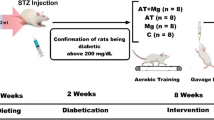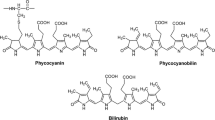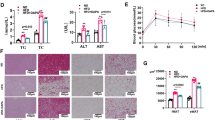Abstract
Luteolin is a major component of many medicinal plants and traditional medicines. The current study aims at testing its protective effect against high-carbohydrate/high-fat (HCHF) diet-induced cardiac dysfunction in rats. Male Wistar rats were divided into six groups as follows: control group that received standard rat chow, group received HCHF diet (~ 30% carbohydrate and 42% fat) daily for 16 weeks, and four groups received HCHF diet concurrently with luteolin (10, 25, 50 or 100 mg/kg; 10% w/v suspension in 0.9% NaCl) daily from the first week by oral gavage. Body weight was measured weekly. At the end of the study, histopathological examinations of stained heart sections were carried out. Lipid profile, oxidative stress, and cardiac function biomarkers were measured. Furthermore, neurohumoral mediators and inflammatory cytokines (TNF-α, IL-18) were assigned. Results showed a significant improvement in cardiac function, tissue integrity, and a decrease in the compensatory neurohumoral mediators by luteolin 50 and 100 mg/kg. In addition, a significant (P < 0.05) decrease in collagen deposition, fibrosis percentage, lipid peroxidation, and inflammatory cells (macrophages and lymphocytes) infiltration was observed. Tested doses of luteolin decreased lipid peroxidation and elevated the endogenous antioxidant biomarkers (reduced glutathione and superoxide dismutase) significantly (P < 0.05). Finally, luteolin decreased TNF-α and IL-18 (P < 0.001) in a dose-dependent manner. It can be concluded that luteolin has a cardioprotective effect against HCHF diet-induced myocardial inflammation through antioxidant anti-inflammatory mechanisms.








Similar content being viewed by others
References
Isomaa, B.O., P. Almgren, T. Tuomi, B. Forsén, K. Lahti, M. Nissén, M.R. Taskinen, and L. Groop. 2001. Cardiovascular morbidity and mortality associated with the metabolic syndrome. Diabetes Care 24: 683–689.
Grundy, S.M. 2004. Obesity, metabolic syndrome, and cardiovascular disease. The Journal of Clinical Endocrinology and Metabolism 89: 2595–2600.
Ford, E.S. 2005. Risks for all-cause mortality, cardiovascular disease, and diabetes associated with the metabolic syndrome: A summary of the evidence. Diabetes Care 28: 1769–1778.
Goldberg, I.J., C.M. Trent, and P.C. Schulze. 2012. Lipid metabolism and toxicity in the heart. Cell Metabolism 15: 805–812.
Mazumder, P.K., B.T. O'Neill, M.W. Roberts, J. Buchanan, U.J. Yun, R.C. Cooksey, S. Boudina, and E.D. Abel. 2004. Impaired cardiac efficiency and increased fatty acid oxidation in insulin-resistant ob/ob mouse hearts. Diabetes 53: 2366–2374.
Abel, E.D., S.E. Litwin, and G. Sweeney. 2008. Cardiac remodeling in obesity. Physiological Reviews 88: 389–419.
Ridker, P.M., N. Rifai, M. Pfeffer, F. Sacks, S. Lepage, and E. Braunwald. 2000. Elevation of tumor necrosis factor-alpha and increased risk of recurrent coronary events after myocardial infarction. Circulation 101: 2149–2153.
Blankenberg, S., L. Tiret, C. Bickel, D. Peetz, F. Cambien, J. Meyer, and H.J. Rupprecht. 2002. Interleukin-18 is a strong predictor of cardiovascular death in stable and unstable angina. Circulation 106: 24–30.
Giugliano, D., A. Ceriello, and K. Esposito. 2006. The effects of diet on inflammation: Emphasis on the metabolic syndrome. Journal of the American College of Cardiology 48: 677–685.
Zheng, C.D., Y.Q. Duan, J.M. Gao, and Z.G. Ruan. 2010. Screening for anti-lipase properties of 37-traditional Chinese medicinal herbs. Journal of the Chinese Medical Association 73: 319–324.
Shang, X., H. Pan, M. Li, X. Miao, and H. Ding. 2011. Lonicera japonica Thunb.: Ethnopharmacology, phytochemistry and pharmacology of an important traditional Chinese medicine. Journal of Ethnopharmacology 138: 1–21.
Sonoda, M., T. Nishiyama, Y. Matsukawa, and M. Moriyasu. 2004. Cytotoxic activities of flavonoids from two Scutellaria plants in Chinese medicine. Journal of Ethnopharmacology 91: 65–68.
Hsiao, W.W., and L. Liu. 2010. The role of traditional Chinese herbal medicines in cancer therapy—From TCM theory to mechanistic insights. Planta Medica 76: 1118–1131.
Tan, B.K., and J. Vanitha. 2004. Immunomodulatory and antimicrobial effects of some traditional Chinese medicinal herbs: A review. Current Medicinal Chemistry 11: 1423–1430.
Yang, M., J. Sun, Z. Lu, G. Chen, S. Guan, X. Liu, B. Jiang, M. Ye, and D.A. Guo. 2009. Phytochemical analysis of traditional Chinese medicine using liquid chromatography coupled with mass spectrometry. Journal of Chromatography. A 1216: 2045–2062.
Kwon, S.M., S. Kim, N.J. Song, S.H. Chang, Y.J. Hwang, D.K. Yang, J.W. Hong, W.J. Park, and K.W. Park. 2016. Antiadipogenic and proosteogenic effects of luteolin, a major dietary flavone, are mediated by the induction of DnaJ (Hsp40) homolog, subfamily B, member 1. The Journal of Nutritional Biochemistry 30: 24–32.
Seelinger, G., I. Merfort, and C.M. Schempp. 2008. Anti-oxidant, anti-inflammatory and anti-allergic activities of luteolin. Planta Medica 74: 1667–1677.
Rauter, A.P., A. Martins, C. Borges, H. Mota-Filipe, R. Pinto, B. Sepodes, and J. Justino. 2010. Antihyperglycaemic and protective effects of flavonoids on streptozotocin-induced diabetic rats. Phytotherapy Research 24: S133–S138.
Kapoor, S. 2013. Luteolin and its inhibitory effect on tumor growth in systemic malignancies. Experimental Cell Research 319: 777–778.
Domitrović, R., H. Jakovac, Č. Milin, and B. Radošević-Stašić. 2009. Dose-and time-dependent effects of luteolin on carbon tetrachloride-induced hepatotoxicity in mice. Experimental and Toxicologic Pathology 61: 581–589.
Rump, A.F.E., M. Schüssler, D. Acar, A. Cordes, M. Theisohn, R. Rösen, W. Klaus, and U. Fricke. 1994. Functional and antiischemic effects of luteolin-7-glucoside in isolated rabbit hearts. General Pharmacology: The Vascular System 25: 1137–1142.
Qi, L., H. Pan, D. Li, F. Fang, D. Chen, and H. Sun. 2011. Luteolin improves contractile function and attenuates apoptosis following ischemia-reperfusion in adult rat cardiomyocytes. European Journal of Pharmacology 668: 201–207.
Fang, F., D. Li, H. Pan, D. Chen, L. Qi, R. Zhang, and H. Sun. 2011. Luteolin inhibits apoptosis and improves cardiomyocyte contractile function through the PI3K/Akt pathway in simulated ischemia/reperfusion. Pharmacology 88: 149–158.
Kaiserová, H., T. Šimůnek, W.J. Van Der Vijgh, A. Bast, and E. Kvasničková. 2007. Flavonoids as protectors against doxorubicin cardiotoxicity: Role of iron chelation, antioxidant activity and inhibition of carbonyl reductase. Biochimica et Biophysica Acta - Molecular Basis of Disease 1772: 1065–1074.
Han, X., J. Pan, D. Ren, Y. Cheng, P. Fan, and H. Lou. 2008. Naringenin-7-O-glucoside protects against doxorubicin-induced toxicity in H9c2 cardiomyocytes by induction of endogenous antioxidant enzymes. Food and Chemical Toxicology 46: 3140–3146.
Wang, S.Q., X.F. Zhu, X.N. Wang, T. Shen, F. Xiang, and H.X. Lou. 2013. Flavonoids from Malus hupehensis and their cardioprotective effects against doxorubicin-induced toxicity in H9c2 cells. Phytochemistry 87: 119–125.
Wang, G., W. Li, X. Lu, P. Bao, and X. Zhao. 2012. Luteolin ameliorates cardiac failure in type I diabetic cardiomyopathy. Journal of Diabetes Complications 26: 259–265.
Yang, J.T., L.B. Qian, F.J. Zhang, J. Wang, H. Ai, L.H. Tang, and H.P. Wang. 2015. Cardioprotective effects of luteolin on ischemia/reperfusion injury in diabetic rats are modulated by eNOS and the mitochondrial permeability transition pathway. Journal of Cardiovascular Pharmacology 65: 349–356.
Madhesh, M., and M. Vaiyapuri. 2012. Effect of luteolin on lipid peroxidation and antioxidants in acute and chronic periods of isoproterenol induced myocardial infarction in rats. Journal of Acute Medecine 2: 70–76.
Horder, M., R.C. Elser, W. Gerhardt, M. Mathieu, and E.J. Sampson. 1990. IFCC methods for the measurements of catalytic concentration of enzymes. VII, IFCC method for creatine kinase (ATP: creatine N-phosphotransferase, EC 2.7. 3.2.). IFCC recommendation. Clinica Chimica Acta 190: S4–S17.
James, J., K.S. Bosch, D.C. Aronson, and J.M. Houtkooper. 1990. Sirius red histophotometry and spectrophotometry of sections in the assessment of the collagen content of liver tissue and its application in growing rat liver. Liver 10: 1–5.
Li, S.Y., X. Yang, A.F. Ceylan-Isik, M. Du, N. Sreejayan, and J. Ren. 2006. Cardiac contractile dysfunction in Lep/Lep obesity is accompanied by NADPH oxidase activation, oxidative modification of sarco (endo) plasmic reticulum Ca2+-ATPase and myosin heavy chain isozyme switch. Diabetologia 49: 1434–1446.
Lee, Y.H., and R.E. Pratley. 2005. The evolving role of inflammation in obesity and the metabolic syndrome. Current Diabetes Reports 5: 70–75.
Engeli, S., R. Negrel, and A.M. Sharma. 2000. Physiology and pathophysiology of the adipose tissue renin-angiotensin system. Hypertension 35: 1270–1277.
Panchal, S.K., H. Poudyal, A. Iyer, R. Nazer, A. Alam, V. Diwan, K. Kauter, C. Sernia, F. Campbell, L. Ward, and G. Gobe. 2011. High-carbohydrate, high-fat diet–induced metabolic syndrome and cardiovascular remodeling in rats. Journal of Cardiovascular Pharmacology 57: 611–624.
Van Harmelen, V., M. Elizalde, P. Ariapart, S. Bergstedt-Lindqvist, S. Reynisdottir, J. Hoffstedt, I. Lundkvist, S. Bringman, and P. Arner. 2000. The association of human adipose angiotensinogen gene expression with abdominal fat distribution in obesity. International Journal of Obesity 24: 673.
Berg, A.H., and P.E. Scherer. 2005. Adipose tissue, inflammation, and cardiovascular disease. Circulation Research 96: 939–949.
Wang, B., and P. Trayhurn. 2006. Acute and prolonged effects of TNF-α on the expression and secretion of inflammation-related adipokines by human adipocytes differentiated in culture. Pflügers Archiv 452: 418–427.
Westermann, D., S. Van Linthout, S. Dhayat, N. Dhayat, A. Schmidt, M. Noutsias, X.Y. Song, F. Spillmann, A. Riad, H.P. Schultheiss, and C. Tschöpe. 2007. Tumor necrosis factor-alpha antagonism protects from myocardial inflammation and fibrosis in experimental diabetic cardiomyopathy. Basic Research in Cardiology 102: 500–507.
Mukherjee, S., S.K. Banerjee, M. Maulik, A.K. Dinda, K.K. Talwar, and S.K. Maulik. 2003. Protection against acute adriamycin-induced cardiotoxicity by garlic: Role of endogenous antioxidants and inhibition of TNF-alpha expression. BMC Pharmacology 3: 1–9.
Ueda, H., C. Yamazaki, and M. Yamazaki. 2002. Luteolin as an anti-inflammatory and anti-allergic constituent of Perilla frutescens. Biological & Pharmaceutical Bulletin 25: 1197–1202.
Kim, J.A., D.K. Kim, O.H. Kang, Y.A. Choi, H.J. Park, S.C. Choi, T.H. Kim, K.J. Yun, Y.H. Nah, and Y.M. Lee. 2005. Inhibitory effect of luteolin on TNF-α-induced IL-8 production in human colon epithelial cells. International Immunopharmacology 5: 209–217.
Jia, Z., P. Nallasamy, D. Liu, H. Shah, J.Z. Li, R. Chitrakar, H. Si, J. McCormick, H. Zhu, W. Zhen, and Y. Li. 2015. Luteolin protects against vascular inflammation in mice and TNF-alpha-induced monocyte adhesion to endothelial cells via suppressing IΚBα/NF-κB signaling pathway. The Journal of Nutritional Biochemistry 26: 293–302.
Woldbaek, P.R., T. Tønnessen, U.L. Henriksen, G. Florholmen, P.K. Lunde, T. Lyberg, and G. Christensen. 2003. Increased cardiac IL-18 mRNA, pro-IL-18 and plasma IL-18 after myocardial infarction in the mouse; a potential role in cardiac dysfunction. Cardiovascular Research 59: 122–131.
Mallat, Z., C. Heymes, A. Corbaz, D. Logeart, S. Alouani, A. Cohen-Solal, T. Seidler, G. Hasenfuss, Y. Chvatchko, A.M. Shah, and A. Tedgui. 2004. Evidence for altered interleukin 18 (IL)-18 pathway in human heart failure. The FASEB Journal 18: 1752–1754.
Srivastava, S., D. Pelloso, H. Feng, L. Voiles, D. Lewis, Z. Haskova, M. Whitacre, S. Trulli, Y.J. Chen, J. Toso, Z.L. Jonak, H.C. Chang, and M.J. Robertson. 2013. Effects of interleukin-18 on natural killer cells: Costimulation of activation through Fc receptors for immunoglobulin. Cancer Immunology, Immunotherapy 62: 1073–1082.
Skurk, T., H. Kolb, S. Müller-Scholze, K. Röhrig, H. Hauner, and C. Herder. 2005. The proatherogenic cytokine interleukin-18 is secreted by human adipocytes. European Journal of Endocrinology 152: 863–868.
Xiao, H., H. Li, J.J. Wang, J.S. Zhang, J. Shen, X.B. An, C.C. Zhang, J.M. Wu, Y. Song, X.Y. Wang, and H.Y. Yu. 2017. IL-18 cleavage triggers cardiac inflammation and fibrosis upon β-adrenergic insult. European Heart Journal 26: ehx261.
Sagawa, H., A. Naiki-Ito, H. Kato, T. Naiki, Y. Yamashita, S. Suzuki, S. Sato, K. Shiomi, A. Kato, T. Kuno, and Y. Matsuo. 2015. Connexin 32 and luteolin play protective roles in non-alcoholic steatohepatitis development and its related hepatocarcinogenesis in rats. Carcinogenesis 36: 1539–1549.
Dhalla, N.S., R.M. Temsah, and T. Netticadan. 2000. Role of oxidative stress in cardiovascular diseases. Journal of Hypertension 18: 655–673.
Galili, O., D. Versari, K.J. Sattler, M.L. Olson, D. Mannheim, J.P. McConnell, A.R. Chade, L.O. Lerman, and A. Lerman. 2007. Early experimental obesity is associated with coronary endothelial dysfunction and oxidative stress. American Journal of Physiology. Heart and Circulatory Physiology 292: H904–H911.
Zhang, Y.C., F.F. Gan, S.B. Shelar, K.Y. Ng, and E.H. Chew. 2013. Antioxidant and Nrf2 inducing activities of luteolin, a flavonoid constituent in Ixeris sonchifolia Hance, provide neuroprotective effects against ischemia-induced cellular injury. Food and Chemical Toxicology 59: 272–280.
Author information
Authors and Affiliations
Corresponding author
Ethics declarations
Conflict of Interest
The authors declare that they have no conflict of interest.
Ethical Approval
All procedures performed were conducted in accordance with the ethical standards of the Scientific Research Ethics Committee, Faculty of Pharmacy in Mansoura University.
Rights and permissions
About this article
Cite this article
Abu-Elsaad, N., El-Karef, A. The Falconoid Luteolin Mitigates the Myocardial Inflammatory Response Induced by High-Carbohydrate/High-Fat Diet in Wistar Rats. Inflammation 41, 221–231 (2018). https://doi.org/10.1007/s10753-017-0680-8
Published:
Issue Date:
DOI: https://doi.org/10.1007/s10753-017-0680-8




